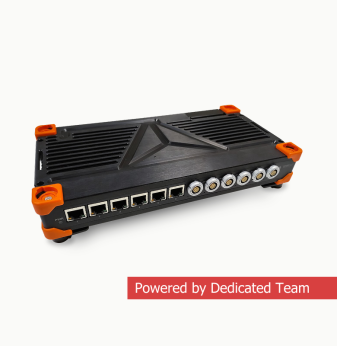How to Protect IP While Outsourcing Embedded Software and Electronics Design

This article answers one of the main questions related to IT outsourcing: how to keep your commercial secrets safe? Here you will learn which valuable information is hidden inside products for the electronics market. We will review the product development process step-by-step to detect the most significant IP within each project so you could provide it with extra protection.
What does a new product for the consumer electronics market consist of? Typically, it is a software and a hardware device: an electronic circuit board, components, embedded operating system, a user interface, an enclosure etc. You can look through the list of nine points as a potential product owner and and determine their importance for your specific project. It will allow you to put correct priorities and pay special attention to the development and the protection of the most valuable parts.
1. Technical study of your idea
Usually, the starting point of the entire project is an idea of your new device. It is important to understand what contains the main value: is it the original idea of the product itself or your plans of its production and promotion (for example, the information is that sales will be launched in an untypical market or the data about manufacturing technology of this particular product that allows to cut production cost and become a market leader)?
The cost of the idea itself is not usually high unless it is your know-how based on many years of scientific research in a specific field.
In order for a product idea to become truly valuable, it is necessary to have technical expertise and feasibility analysis; only after that all the information on the project will be gathered into requirements specification and a business plan the important confidential documents which have to be accessible only for a limited circle of trusted people.
At the same time, the idea itself can be openly discussed with potential investors and business partners. However, it is not always obvious. Many young entrepreneurs are afraid of sharing this information believing that their potential investor can use it to build a new product or service without them.
2. Hardware
The next step is hardware design: component selection, PCB design and tracing according to your requirements. At this stage, the main value is hidden in the implementation of specific design solutions: in the description of the circuitry and PCB design, and in the selected list of required electronic components.
Typically, the electronics development based on standard solutions, which are used in millions of other similar devices around the world: circuitry, the architecture of components connection, etc. In certain products, all hardware can be based on reference designs.
For example, a qualified engineer can copy a cell phone circuitry (the value of this project is 2 or 3 man-months), but he or she will not be able to launch the production and assembly, nor get unique components designed for this phone at the same cost. Thus, he or she will not be able to copy the product as it is.
3. Software
At this stage, an operating system will be chosen and all the software components of your device will be developed, including drivers, quality control tests for production, user software, etc.
The software development in total project costs constantly rises, it is a global tendency, while labour costs are reduced by using ready solutions with open source. The programmer’s work is reducing through integration and optimization. Thus, the uniqueness of software is reducing. It can be represented only by some specific elements, for example, unique power-saving algorithms, voice processing, noise reduction, etc. These are the very elements that need extra protection and everything else has much less value.
4. User interface and enclosure design
When a product gets its custom enclosure and graphic interface, the list of your intellectual property is growing with architecture, your custom user interface, mechanical and 3D enclosure design — all these things define the unique perception of the product.
Visual elements of electronic devices are often copied from other popular solutions on the market. In this case, they do not need special IP protection. However, if a product has certain unique visual features, this information has to be kept secret until the product release, when this information goes public.
5. List of licenses
An owner of a future product can obtain various licenses: for example, sign contracts to use certain audio or video formats (mp3, AAC, MPEG 4, Dolby etc.). These licenses will affect the future price of the product. If we speak about public technologies, the license purchasing conditions will likely to be the same for all the market players. However, if you obtain an exclusive license or agree on some special terms with a licensor, then these contractual terms can affect the functionality and the cost of your final product, ensuring its uniqueness and extra protection.
6. Components
Electronic components and other parts define the cost of the device, its quality, delivery terms and warranty obligations. All these things together influence the competitiveness of your product.
Some of the key criteria for success here are BOM optimization and partnerships with distributors. Distributors will help you to create a list of potential replacements to reduce the cost of your final product or to improve its technical features.
The results of this phase are contracts with specific delivery terms and exclusive prices for processors, memory chips and other important components of your device. Typically, there is a lot of work behind each contract: negotiating experience, the reputation of your company, results of cooperation with global technology vendors, etc.
The value of these contractual terms becomes evident during the production phase (at the design stage you can rely only on general terms imited list of key components suppliers).
7. Manufacturing of your device
A specific contract manufacturer should be selected during the development process. This way you can account for their technological possibilities and requirements, as well as add the cost of their services to your budget.
As a result, you get a list of specific contractors who have certain technologies to manufacture electronics and enclosure parts, as well as information on where and how the assembly and packaging of your device will be conducted. The most valuable information at this stage is the selected technology, costs, quality, and timeframes.
8. Market entry and sales launch
The project comes to its final straightaway: the preordered goods are shipped, and the new device is delivered to retail networks.
Of course, the marketing plan is being made during the process of concept development. It is difficult to overestimate the importance of this document because the same product can either win the market or fail because of promotion approaches.
At this stage the product owner has a delivery set made with the technology for mass production: it is a ready device in its original package with instructions, a set of cables and other necessary accessories.
Also, a valuable component of the project is the information about plans and regions of sales; that includes analysis of markets and potential suppliers, signed supply contracts, transfer of exclusive sales rights, approved price of the product, a list of related products and services.
9. Technical support
The list of costs of the project also includes the after-sales service of the device, and that, in its turn, affects the price of the product and its attractiveness for customers. At the stage of the technical support organization, a list of events and conditions that are available to the end-user (warranty, technical support, etc.) appears.
Thus, if we make a chat of the project costs needed to develop a product for the electronics market taking into account development, manufacture and sales, we can make two reference charts for different types of electronic devices (with very approximate but illustrative proportions):

A high technology device for industrial applications

A device for the mass consumer market
Charts: the distribution of costs of the development, manufacture, and sales of measuring scientific equipment (with the production batch of 1 to 10 pieces) and for a smartphone designed for the mass consumer market (with the production batch of 1 million pieces).
In the first example, the main value of the product is in the development, and in the second one, the main value is in promotion and sales. Of course, those figures will considerably vary depending on the features of a specific project. It is extremely difficult to get information about someone else's products in detail because it is a commercial secret. Analysts in the field of information technology can operate only with available public data, by getting insider reports, and by conducting their own research as well.
For example, in 2015, when Apple brought its watch to marketa, the IHS analytical company published its calculations of the costs for electronic components for that product. The hardware platform of Apple Watch made only 24% of the announced retail cost. Assembly and testing costs made $ 2.5. The total production cost made $83.7. Consequently, the remaining $265.3 included profit, marketing costs, software development, and in a number of other related expenses that we mentioned in this article.
As can be seen from our examples and reflections, the product owners should identify the value of each stage of the project and focus on their key competence (it has the highest priority for protection). All the rest can be outsourced.
So if you create a unique technology device in a limited batch, the most valuable information on the project is the name of your customer and the scientific component of your device. If you operate on the mass consumer market, your trump card could be a unique sales plan and an attractive design. If you design electronic products for the industrial application, the key elements of the project may be the price, reliability and maintainability of your device.
Competent control of the information that you share with external teams can significantly reduce the risks. Do not be afraid to share the information on non-unique components of your device, which make a small part of your personal list of intellectual property.
Our projects








